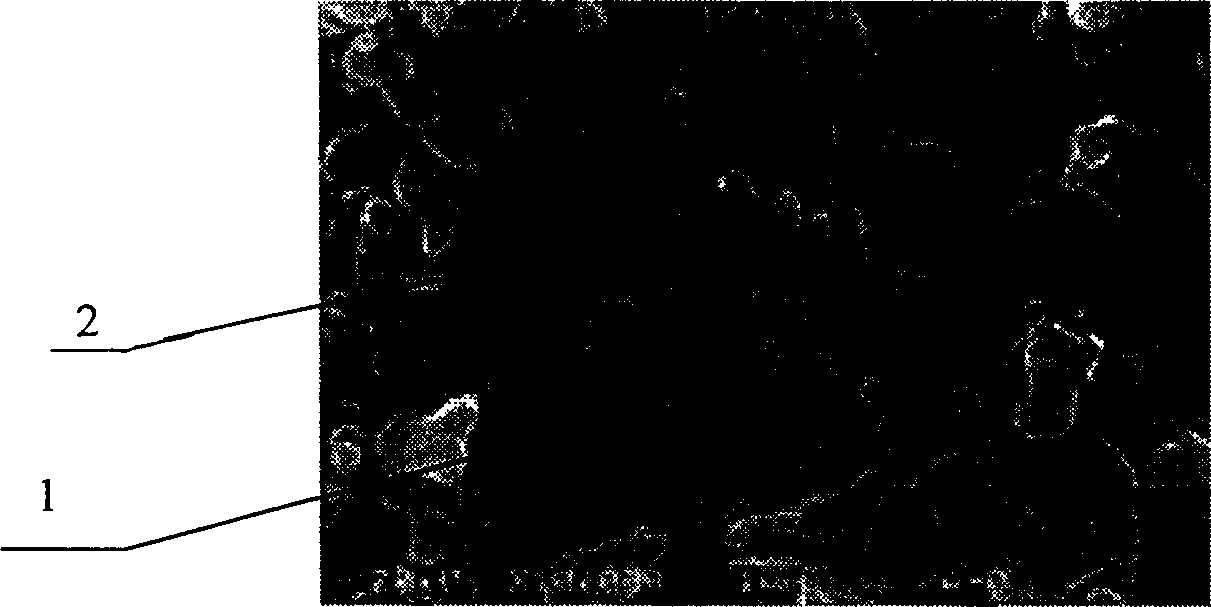Biological active nano titanium oxide ceramic for hard tissue repairing and its preparing method
A bioactive, titanium oxide technology, applied in the field of biomedical material preparation, can solve the problems of restricting the use of low- and middle-income patients, high cost of bioactive glass, and high cost, and achieve the effect of reducing economic burden, easy realization, and convenient operation
- Summary
- Abstract
- Description
- Claims
- Application Information
AI Technical Summary
Problems solved by technology
Method used
Image
Examples
Embodiment 1
[0023] The invention prepares bioactive titanium oxide ceramics, adopts rutile nano-titanium oxide powder as raw material, adds 2.5% by mass percentage of magnesium oxide powder as a grain growth inhibitor, and uses analytical pure alcohol as a solvent to mix rutile nano-titanium oxide powder with oxidation Submerge the magnesium powder in alcohol, and then use an ultrasonic generator to fully mix the above powder under the action of ultrasonic waves for 10 minutes, then dry it at room temperature, and use a cold isostatic press under 50MPa pressure to dry the mixed powder Then put the formed green body into the muffle furnace for sintering, and raise it to the holding temperature at a heating rate of 10°C / min. At this time, the holding temperature is 1000°C. After holding at the holding temperature for 2 hours, cool with the furnace At room temperature, titanium oxide ceramics with both biological activity and crystallization can be obtained.
Embodiment 2
[0025] Using anatase nano-titanium oxide powder as raw material, adding 5% alumina powder as a grain growth inhibitor, using analytical pure alcohol as a solvent, submerging anatase nano-titanium oxide powder and alumina powder In alcohol, use an ultrasonic generator to fully mix the above powder for 20 minutes under the action of ultrasonic waves, and then dry it at room temperature. Use a cold isostatic press to shape the dried mixed powder under a pressure of 150 MPa, and then put The shaped green body is put into a muffle furnace for sintering, and is raised to the holding temperature at a heating rate of 50°C / min, and the holding temperature is 600°C at this time. After being kept at the heat preservation temperature for 5 hours, and then cooled to room temperature with the furnace, a titanium oxide ceramic having both biological activity and crystallization can be obtained.
Embodiment 3
[0027] Using composite nano-titanium oxide powder with rutile powder and anatase powder as raw material, adding calcium pyrophosphate powder with a mass percentage of 1% as a grain growth inhibitor, and using analytical pure alcohol as a solvent, the above two composite powders Submerge the material and calcium pyrophosphate powder in alcohol, and then use an ultrasonic generator to fully mix the above powder under the action of ultrasound for 30 minutes, then dry it at room temperature, and use a cold isostatic press under 200MPa pressure to dry the The mixed powder is formed, and then the formed green body is sintered in a muffle furnace, and the temperature is raised to the holding temperature at a heating rate of 10°C / min, and the holding temperature is 1200°C at this time. After being kept at the heat preservation temperature for 3 hours, and then cooled to room temperature with the furnace, a titanium oxide ceramic having both biological activity and crystallization can b...
PUM
| Property | Measurement | Unit |
|---|---|---|
| particle diameter | aaaaa | aaaaa |
| size | aaaaa | aaaaa |
Abstract
Description
Claims
Application Information
 Login to View More
Login to View More - R&D
- Intellectual Property
- Life Sciences
- Materials
- Tech Scout
- Unparalleled Data Quality
- Higher Quality Content
- 60% Fewer Hallucinations
Browse by: Latest US Patents, China's latest patents, Technical Efficacy Thesaurus, Application Domain, Technology Topic, Popular Technical Reports.
© 2025 PatSnap. All rights reserved.Legal|Privacy policy|Modern Slavery Act Transparency Statement|Sitemap|About US| Contact US: help@patsnap.com

